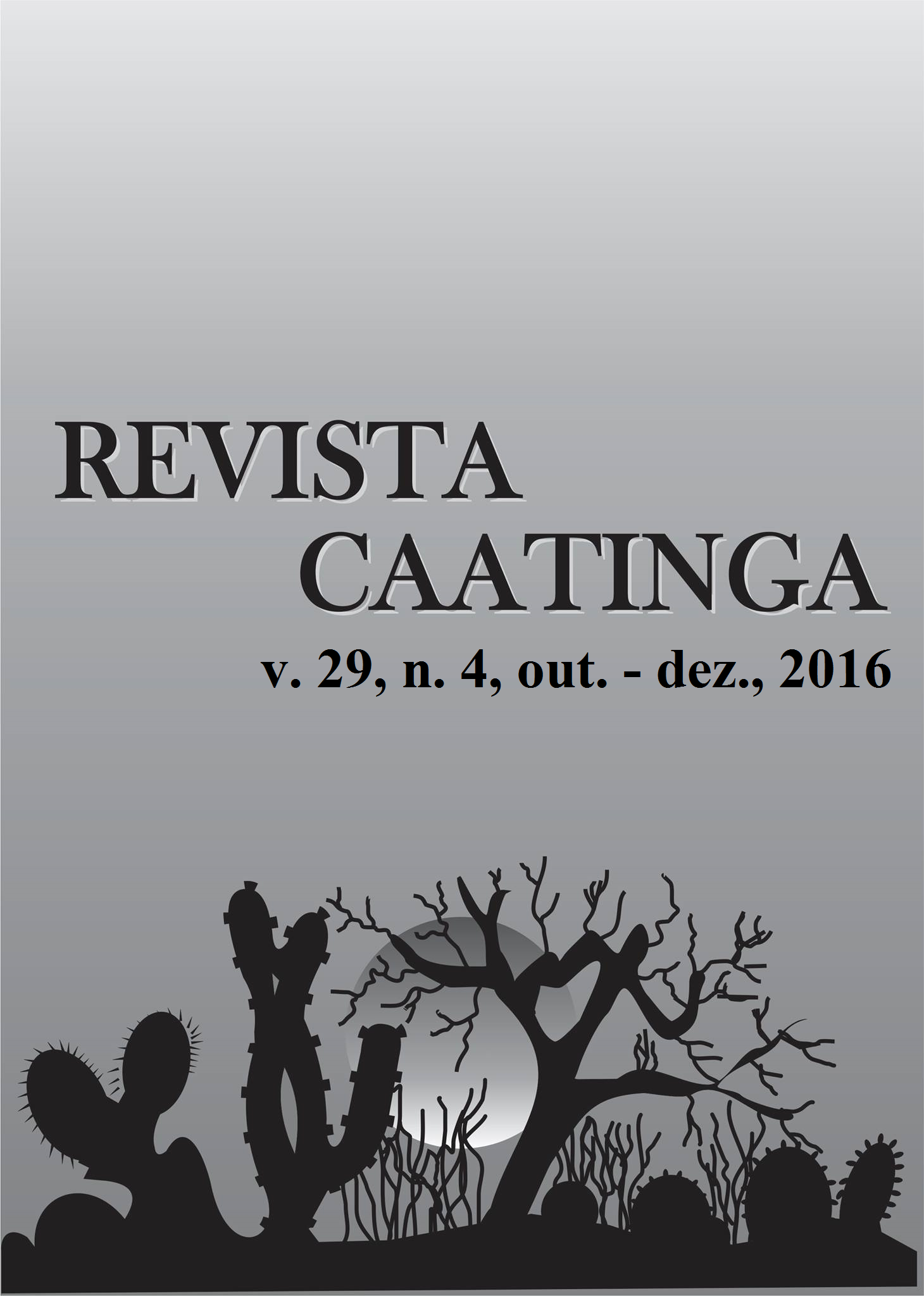EARLY DEVELOPMENT OF CASTOR BEANS GROWN UNDER SALINITY CONDITIONS (VARIETIES BRS ENERGIA, MPA 34 AND MPB 01)
DOI:
https://doi.org/10.1590/1983-21252016v29n404rcKeywords:
Ricinus communis. Sodium sensitivity. Osmotic adjustment.Abstract
Studies have shown that some plant species exhibit satisfactory production levels when grown under high salinity levels, whereas others exhibit decreased production due to sodium sensitivity even at low sodium concentrations. The castor bean is moderately sensitive to salinity. The aim of the present study was to evaluate the early growth of three castor bean varieties (BRS Energia, MPA 34 and MPB 01) grown in nutrient solution with increasing sodium concentrations (control, 25, 50, 75 and 100 mmol L-1). A completely randomized split-plot experimental design was used, with a 5x3 factorial scheme and three replicates per treatment. Salinity resulted in decreased dry weight of all castor bean varieties grown for 31 days under hydroponic conditions. The dry weight accumulation was less affected at the root than at the shoot level. Nevertheless, the shoot dry weight decreased with the increasing salinity. MPA 34 exhibited higher early growth than the remaining tested varieties. Salinity affected the early development of the tested castor bean varieties, and this effect was more pronounced at the shoot than at the root. Variety MPA 34 is promising for cultivation under moderate salinity levels.Downloads
References
ARAGÃO, C. A. et al. Avaliação de cultivares de melão sob condições de estresse salino. Revista Caatinga, Mossoró, v. 22, n. 2, p. 161-169, 2009.
AYERS, R. S.; WESTCOT, D. W. A qualidade da água na agricultura. 2. ed. Campina Grande: UFPB, 1999. 218 p. (Estudos da FAO, Irrigação e Drenagem, 29).
BRAY, E. A.; BAILEY-SERRES, J.; WERETILNYK, E. Responses to abiotic stresses. In: BUCHANAN, B. B.; GRUISSEM, W. JONES, R.L. (Eds.). Biochemistry & Molecular Biology of Plants. American Society of Plant Physiologists, 2000. v. 1, cap. 22, p. 1158-1203.
CARUSO, G.; VILLARI, G. Effect of EC-level and plant shading on the NFT-grown "Friariello Pepper". Acta Horticulturae, East Lansing, v. 659, n. 2, p. 576-585, 2004.
CAVALCANTI, M. L. F. et al. Tolerância da mamoneira BRS 149 à salinidade: germinação e características de crescimento. Revista Brasileira de Engenharia Agrícola e Ambiental, Campina Grande, v. 9, Sup., p. 57-61, 2005.
CHEESEMAN, J. M. Mechanisms of salinity tolerance in plants. Plant Physiology, Rockville, v. 87, n. 1, p. 547-550, 1988.
CONAMA. Considerando ser a classificação das águas doces, salobras e salinas essencial à defesa de seus níveis de qualidade, avaliados por parâmetros e indicadores específicos, de modo a assegurar seus usos preponderantes. Diário Oficial da União, Brasília, 1986.
COSME, C. R. et al. Produção de tomate hidropônico utilizando rejeito da dessalinização na solução nutritiva aplicados em diferentes épocas. Revista Brasileira de Engenharia Agrícola e Ambiental, Campina Grande, v. 15, n. 5, p. 499–504, 2011.
HOAGLAND, D. R.; ARNON, D. I. The water culture method for growing plants without soil. Berkeley, Califórnia: College of Agriculture, University of California, 1950. 347 p.
KLUGE, M; TING, I. P. Crassulace an Acid Metabolism: Analysis of an Ecological Adaptation. Springer - Verlag, Berlin, 1978.
KORNDÖRFER, G. H. Elementos benéficos In: FERNANDES, M. S. (Ed.). Nutrição mineral de plantas. Viçosa: Sociedade Brasileira de Ciência do Solo, 2006. v. 1, cap. 14, p. 355-374.
MAAS, E.V.; HOFFMAN, G.J. Crop salt tolerance-current assessment. Journal of Irrigation and Drainage Engineering, Delaware, v. 103, n. 6, p. 115 134, 1977.
MARSCHNER, H. Mineral nutrition of higher plants. 2. ed. San Diego, USA: Academic Press, 1997. 889 p.
NUNES, R. L. C. et al. efeitos da salinidade da solução nutritiva na produção de pimentão cultivado em substrato de fibra de coco. Revista Caatinga, Mossoró, v. 26, n. 4, p. 48–53, 2013.
PINHEIRO, H. A. et al. Leaf gas exchange, chloroplastic pigments and dry matter accumulation in castor bean (Ricinus communis L.) seedlings subjected to salt stress conditions. Crop Production, Ithaca, v. 27, n. 1, p. 385-392, 2008.
RUBIO, J. S. et al. blossom-end rot incidence, and fruit quality in pepper plants under moderate salinity are affected by K+ and Ca2+ fertilization. Scientia Horticulturae, Amsterdam, v. 119, n. 1, p. 79-87, 2009.
SANTOS, J. B. et al. Comportamento morfofisiológico da mamoneira BRS Energia submetida à irrigação com água salina. Revista Brasileira de Engenharia Agrícola e Ambiental, Campina Grande, v. 17, n. 2, p. 145-152, 2013.
SAS INSTITUTE INC. Statistical Analysis System user's guide. 1. ed. Cary, EUA, v. 9, 2002. 513 p.
SAVVAS, D. et al. Interactions between salinity and irrigation frequency in greenhouse pepper grown in closed-cycle hydroponic systems. Agricultural Water Management, Amsterdam, v. 91, n. 3, p. 102-111, 2007.
SILVA, J. K. M. et al. Efeito da salinidade e adubos orgânicos no desenvolvimento da rúcula. Revista Caatinga, Mossoró, v. 21, n. 5, p. 30-35, 2008a.
SILVA, S. M. S. et al. Desenvolvimento e produção de duas cultivares de mamoneira sob estresse salino. Revista Brasileira de Engenharia Agrícola e Ambiental, Campina Grande, v. 12, n. 4, p. 335-342, 2008b.
SILVA JÚNIOR, J. F. et al. Crescimento inicial de algodoeiro herbáceo submetido a estresse salino. Revista Caatinga, Mossoró, v. 1, n. 1, p. 42-47, 2013.
Downloads
Published
Issue
Section
License
Os Autores que publicam na Revista Caatinga concordam com os seguintes termos:
a) Os Autores mantêm os direitos autorais e concedem à revista o direito de primeira publicação, com o trabalho simultaneamente licenciado sob a Licença Creative Commons do tipo atribuição CC-BY, para todo o conteúdo do periódico, exceto onde estiver identificado, que permite o compartilhamento do trabalho com reconhecimento da autoria e publicação inicial nesta revista, sem fins comerciais.
b) Os Autores têm autorização para distribuição não-exclusiva da versão do trabalho publicada nesta revista (ex.: publicar em repositório institucional ou como capítulo de livro), com reconhecimento de autoria e publicação inicial nesta revista.
c) Os Autores têm permissão e são estimulados a publicar e distribuir seu trabalho online (ex.: em repositórios institucionais ou na sua página pessoal) a qualquer ponto antes ou durante o processo editorial, já que isso pode gerar alterações produtivas, bem como aumentar o impacto e a citação do trabalho publicado (Veja O Efeito do Acesso Livre).







